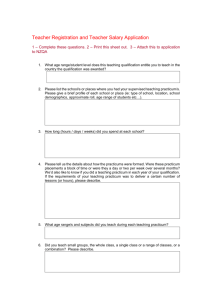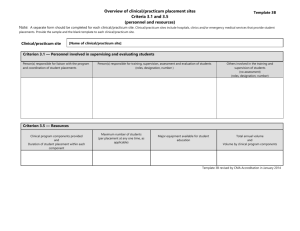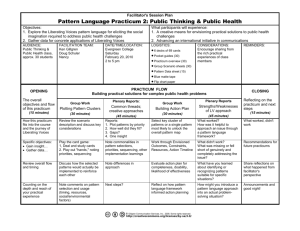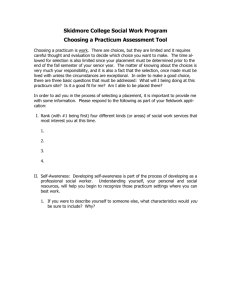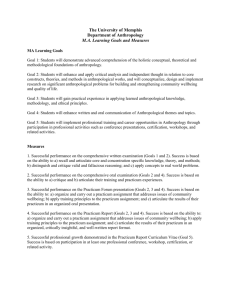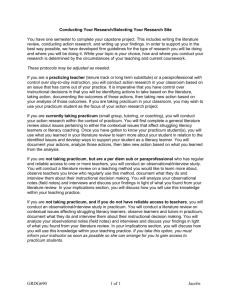Overview - Nicklaus Children`s Hospital
advertisement
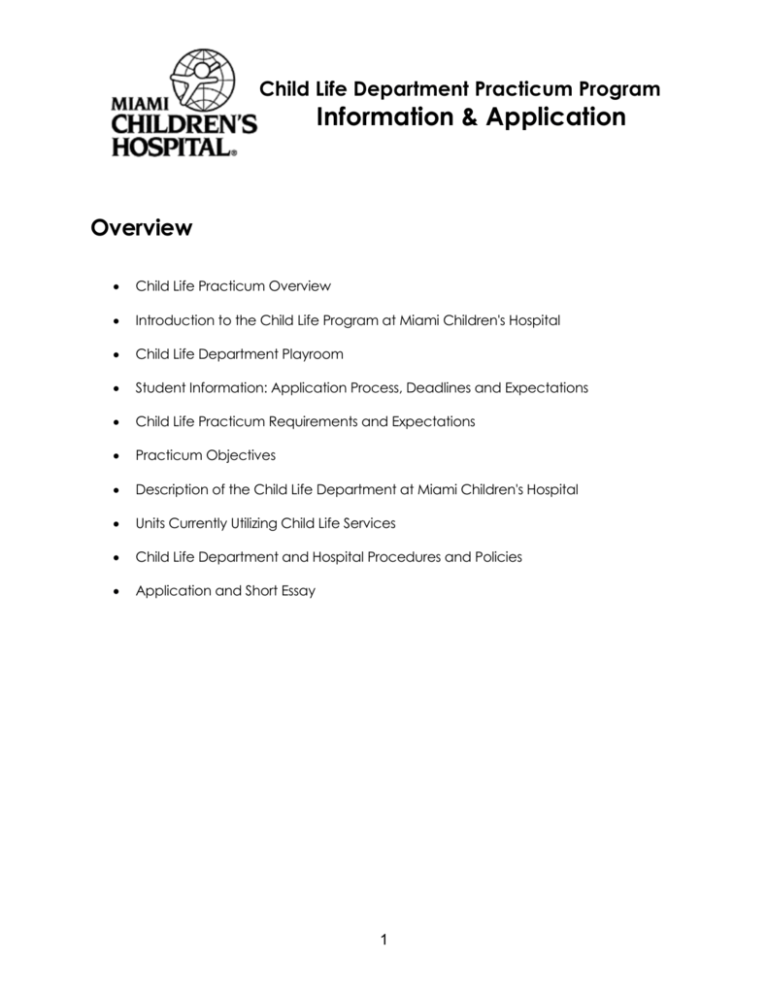
Child Life Department Practicum Program Information & Application Overview Child Life Practicum Overview Introduction to the Child Life Program at Miami Children's Hospital Child Life Department Playroom Student Information: Application Process, Deadlines and Expectations Child Life Practicum Requirements and Expectations Practicum Objectives Description of the Child Life Department at Miami Children's Hospital Units Currently Utilizing Child Life Services Child Life Department and Hospital Procedures and Policies Application and Short Essay 1 Child Life Department Practicum Program Information & Application Introduction MIAMI CHILDREN'S HOSPITAL is a private, non-profit institution which cares for children from birth through twenty-one years of age. It is a 275 bed facility. The hospital was established in March 1950 as Variety Children's Hospital. CHILD LIFE PRACTICUM STUDENTS will work with the Volunteer Services Department for health, security, insurance, volunteer benefits and documentation purposes. CHILD LIFE PRACTICUMS are a minimum of 128 hours over the course of a semester. SELECTION OF CHILD LIFE PRACTICUM STUDENTS is on a basis of academics, previous experience working with children, references, and an interview. ORIENTATION is provided by Community & Volunteer Resources and the Child Life Department. HOURS are coordinated with the Child Life Department. UNIFORMS must comply with Miami Children's Hospital's employee dress code and the dress code of the Child Life Department. A Hospital I.D. must be worn at all times. APPLICATION PROCEDURE: Please complete the enclosed application. Send your resume, and at least two letters of reference (one from an academic advisor, and one from a professor) along with your completed application to: Miami Children's Hospital Child Life Department Practicum Program 3100 SW 62 Avenue Miami, Florida 33155 Once we receive and review your application, we will contact you for a possible interview. We appreciate your interest in Miami Children's Hospital. If you have any questions please call the Child Life Practicum Coordinator at 305-666-6511 ext. 4875. 2 Child Life Department Practicum Program Information & Application Introduction to the Child Life Department The Child Life Department at Miami Children's Hospital seeks to reduce the stress and anxiety which a child and family may feel when faced with a hospital experience. Upon entering the hospital a child encounters strangers in a strange place, unusual equipment, unfamiliar sounds and smells and the fear of inherent pain or discomfort. The Child Life Staff try to assist children in making sense of this place called a hospital: to explain tests, procedures and routines in a developmentally appropriate manner, to replace the fear of the unknown with knowledge and understanding and to provide the most positive experience possible in this setting. Through a variety of programs Child Life can look at meeting the emotional, recreational, and social needs of children during hospitalization. Child Life Department Playroom PHILOSOPHY: The Playroom is a child's safe haven. It is one aspect of the child's hospitalization where s/he has some control of the hospital environment; a child can decide to come to the Playroom and participate in special activities, free play, or may choose not to come at all. This special place allows children to have an opportunity to socialize with other children who may share similar experiences. In addition, it is a place where children may choose from an array of activities: to paint, color, play games, put together puzzles, create objects, make crafts projects, listen to music, work on developmental tasks, make friends, experience or sit and enjoy watching others play. SAFETY ZONE: Perhaps the most unique thing about the Playroom is that once children walk through the door they know they are safe from all medical procedures, examinations, temperature, blood pressures, medications, and especially needles! Remember a child's work is his or her play. However, we do invite doctors, nurses, therapists, other hospital staff, as well as parents and visitors to come in and observe play or sit and talk with the children. PLAYROOM: The main Playroom is located on the third floor. The Playroom is open to children that are medically cleared by their doctor or nurse. (For those who cannot come to the Playroom, the Child Life Specialist is available to visit at the bedside and provide activities). 3 Child Life Department Practicum Program Information & Application Practicum Information 1. Child Life Practicum Application Process: Students interested in the Child Life Practicum Program should follow the time schedule below for the application procedure. Practicum Session Application Deadlines Acceptance Deadlines Fall May 5 May 15 Winter/Spring November 5 November 15 Start Date Mid/End of AugDec Beginning of JanMay A. Application: An application for Practicum is included in this packet. Please return it along with your resume and two letters of recommendation. B. Interviews: A phone interview will be arranged by the Child Life Practicum Coordinator. They will be contacting you to set up a date and time C. Acceptance: Students will be notified of their acceptance into the Practicum Program on or before the date specified above. D. Housing Arrangements: The hospital does not have housing for Child Life Practicum students. E. Vaccinations/Background Check: Rubella Titer and Skin Tests will be administered by the hospital at the start of the Practicum. Background checks will be required of all Practicum students; this check can be completed through Volunteer Resources. X4431 F. Stipend: No stipend is paid to Child Life Practicum students. G. Duration: a. The practicum experience is optional total of 16 weeks coming in 1x a week or for 10 weeks 2x a week all depending on the students availability and staff availability at that time. b. The Practicum student will shadow three different units over the course of the practicum experience. Each rotation will vary for a total of four –five weeks. 4 Child Life Department Practicum Program Information & Application H. To be considered for a Child Life Practicum, students must be Junior level status (at the time of the practicum) or must have already obtained a Bachelor’s degree. Suggested majors for Practicum candidates are: Child Life, Child Development, Family and Human Development, Early Childhood Education, Special Education, Recreation Therapy and Psychology. I. It is not required for the Practicum Advisor to visit the site during the practicum experience. J. Students will complete an in depth orientation during the first week of the Practicum. Completion of reading the Child Life Policy and Procedure Manual is required. Students are asked to outline their goals and objectives for the Practicum. K. Recommended readings: The Child Life Handbook Meeting Children’s Psychosocial Needs Across the Healthcare Continuum Psychosocial Care of Children in Hospitals Child Life in Hospitals Theory and Practice Theories of Development Concepts and Application Official Documents Of the Child Life Council L. Child Life Practicum students are expected to conduct themselves as professional members of the Child Life Department. M. Child Life Practicum students will be required to work 8 hours per week (one 8 hour shift or two four hour shifts) including day, evening. N. Weekly conferences will be scheduled between the unit supervisors and practicum coordinators; and the Practicum students focusing on the student's progress, concerns, current events and scheduling issues. O. Students will be required to complete two self-evaluations, one mid-term and one final. P. Child Life Practicum students must meet all requirements of the Practicum. Failure to complete the requirements may cause the student to receive an Incomplete. See requirements listed on next page. 5 Child Life Department Practicum Program Information & Application Practicum Objectives Introduction The Child Life Practicum Program at Miami Children's Hospital is offered year round to interested students in various curriculums. The program provides students opportunities for: 1. To become familiar with the Child Life Profession. 2. To develop a working knowledge of growth and development. 3. To gain experience in providing appropriate developmental activities for children of all age groups. 4. To assess the child’s age, stage of development, and ability to perform a planned activity. 5. To observe Child Life Specialists interactions with members of the multidisciplinary team. 6. To increase knowledge of medical terminology and procedures. 7. To increase knowledge of the roles of other members of the multidisciplinary team, and how they collaborate with Child Life. 8. To understand the importance of educating other healthcare professionals about the psychosocial needs of children and families through in-services and individual contact. 9. To observe a Child Life Specialist performing their duties in all facets of their job, including pre-operative teaching, normalization of hospital environment, grief and bereavement support, parenting education, administrative duties. 6 Child Life Department Practicum Program Information & Application The Child Life Specialist will act as site supervisor. It is the responsibility of the Child Life Specialist to: 1. Orient the student to the hospital including policies, programs, departments and procedures. 2. Share knowledge and experiences with the student which will help him/her grow professionally. 3. Assign responsibilities to the student that are consistent with the Child Life Department. 4. Provide opportunities to attend seminars, workshops, etc, pertinent to hospitalized children and professional growth. 5. Complete any or all university evaluations or letters of recommendation for the student file. Child Life Department Description The Child Life Department seeks to: 1. Provide a safe, non-threatening environment that allows for expression through positive outlets and normalcy in an unfamiliar setting. 2. Help the child and family gain greater understanding of medical procedures, thus reducing fear of the unknown and stress. Child Life personnel including: Child Life Specialists, Child Life Assistants, Student Interns, and specially trained volunteers provide recreational, therapeutic, developmental and educational programming for children and their families in order to make the hospital experience as positive as possible. 7 Child Life Department Practicum Program Information & Application Units Currently Utilizing Child Life Services Emergency Room: Patients visit the ER for a variety of diagnoses including motor vehicle accidents, lacerations, fever, vomiting, and diarrhea. 2 North East (Cardiac Critical Care Unit): A 27 bed Critical Care Unit for patients undergoing heart surgery and/or hospitalized with complications from heart disease. PICU (Pediatric Intensive Care Unit): a 16 bed unit for patients requiring intense medical care. Same Day Surgery: Patients who are having surgery and go home the same day. Example: tonsillectomy, hernia repair, circumcision. 2-East: a 30 bed Medical/Surgical unit with patients requiring several kinds of surgery including: Scoliosis and spinal disorders, fracture repairs, limb length Inequalities and Deformities, and sports related problems. 3 East: a 30 bed Respiratory unit admitting patients with illnesses such as asthma, RSV, cystic fibrosis, pneumonia, bronchiolitis, etc. 3-North: a 26 bed Hematology/Oncology unit including patients with various forms of Cancer, brain tumors, Sickle Cell Anemia, and Blood Disorders. A 3 bed Bone Marrow Transplant Unit and Infusion Unit. 3-North East: a 30 bed general medical unit admitting patients with chronic illnesses such as kidney disease, diabetes, crohn’s disease, and patients receiving dialysis treatments. Also includes an Outpatient Dialysis Unit. 3-South: a 30 bed Neuro/Surgical unit admitting patients with a variety of neurological diagnosis such as: seizure disorders, behavior disorders, meningitis, and brain tumors. 8 Child Life Department Practicum Program Information & Application Child Life Department & Hospital Policies/ Procedures Bedside Care: Always talk with a patient's nurse before removing a patient from her/his bed. Always put the guardrails up before leaving any patients room. Transporting Patients: A patient being transported must wear a seat belt while in the wheelchair. Otherwise patients can walk to and from the Playroom. Food for Patients: Whenever a Child Life activity involves food or drink, Child Life Personnel must obtain a dietary report on all patients able to attend Playroom activities. Community groups providing entertainment to the hospital are not allowed to bring candy or food to patients. Food and drinks are not allowed in the Playroom without specific approval of the Child Life Specialist. Isolation: Patients requiring isolation are still eligible for Child Life Services at the bedside. Strict adherence to the isolation policies is required. Hygiene: Frequent hand washing is of the utmost importance when working with patients. Always wash your hands well after working with individual patients and after a group activity in the Playroom. Photographs: Patients cannot be photographed without the written permission of the parents or legal guardian and must have hospital authorized Consent Forms (obtained from Child Life Staff). Confidentiality: Any information concerning a patient's condition, treatment, personal affairs or records shall be kept confidential. Religious Matters: No religious or political subject matter may be impressed upon patients, families or visitors. This includes the gifts distributed by visiting groups. Dress Code: Child Life Practicum students are required to present a well groomed, professional appearance which inspires the confidence of patients, families and visitors. Comfortable yet neat clothing is suggested considering the environment and type of work situations present. Blue jeans, shorts, tank tops and open toed shoes are not allowed. Smoking: The hospital is a smoke free facility. Illness: Notify your Child Life Specialist if you feel you are ill. Your patient contact may be restricted until you are feeling better. Hours missed due to illness will be required to be made up. 9 Child Life Department Practicum Program Information & Application Child Life Practicum Application Send two letters of reference, and resume along with your application. Name: Phone: E-Mail Address City State Date of Birth: Social Security No: School: Phone: Address: City State Phone Last Major: Professor: Check semester you plan to Spring Summer Zip Zip year of college completed? Fall complete a practicum: HAVE YOU EVER DONE VOLUNTEER WORK OR HAD A PREVIOUS PRACTICUM? IF YES, PLEASE DESCRIBE: LIST SKILLS OR INTERESTS YOU HAVE THAT WOULD BE OF VALUE DURING YOUR PRACTICUM: HAVE YOU EVER BEEN CONVICTED OR ADJUDICATED GUILTY (INCLUDING NOLO CONTENDERE) FOR AN OFFENSE OTHER THAN A MINOR TRAFFIC VIOLATION? [ ]YES ]NO IF YES PLEASE EXPLAIN: REFERENCES: (give name, address, and phone number for at least two references) Name: Phone: How you know Address City State Name: Phone: How you know Address City State 10 Zip Zip [ Child Life Department Practicum Program Information & Application EMERGENCY CONTACT: (GIVE NAME, ADDRESS AND PHONE) Name: Phone: How you know Address City State Family Physician: Phone: Signature Date: Zip Explain your philosophy of the Child Life profession. This hospital fully complies with the Age Discrimination in Employment Act of 1968 and the Civil Rights Act of 1964 which prohibits employment discrimination based upon race, color, creed, sex, age, national origin, physical disability or veteran status. A Criminal Conviction record search is made of all prospective volunteers of the hospital. A conviction record is not necessarily a bar to employment; factors such as age and time of offense, seriousness and nature of violation and rehabilitation will be taken into account. However, concealment of any conviction on this application shall be cause for discharge. 11
